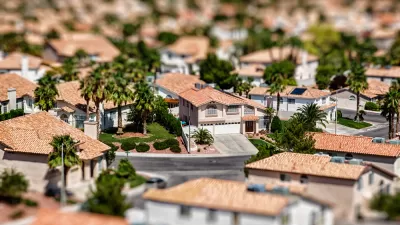Density -- either high or low or somewhere in the middle -- is a key defining element of our cities. In this essay, Witold Rybczynski looks at the relative densities of U.S. cities and suggests that things may start to change subtly.
"There are a number of ways in which American cities could become denser. In vertical downtowns, tall buildings could simply get taller, or older office towers could be converted to residential use, as has happened in some business districts. The most common form of urban densification is the conversion of disused waterfronts, decommissioned Navy yards, and obsolete industrial areas into housing and office developments, an attractive strategy since it does not displace existing residents. In older city neighborhoods, taller structures could progressively replace three- or four-story row houses and low apartment buildings, though community resistance makes this a slow process.
Suburban densification is more challenging. In Philadelphia, where I live, it was common practice in the mid-20th century to subdivide large suburban estates into communities of single-family houses, but such open spaces in the suburbs are increasingly rare. Neighborhoods of single-family housing can be made denser by building clusters of smaller houses on what were previously large single-house lots, or by introducing row houses or low-rise apartment buildings. Both strategies involve radical changes to neighborhood identity, however. Perhaps the greatest challenge will be to increase density in the large planned-unit communities that have proliferated in the past few decades. In these, any change is constrained by homeowner associations in which even a small minority of members can effectively block alterations they find objectionable."
In this discussion of density and cities, Rybczynski wonders if spread-out urbanity will continue, if urban density will take hold, or if it will be a combination of the two.
FULL STORY: Dense, Denser, Densest

Maui's Vacation Rental Debate Turns Ugly
Verbal attacks, misinformation campaigns and fistfights plague a high-stakes debate to convert thousands of vacation rentals into long-term housing.

Planetizen Federal Action Tracker
A weekly monitor of how Trump’s orders and actions are impacting planners and planning in America.

In Urban Planning, AI Prompting Could be the New Design Thinking
Creativity has long been key to great urban design. What if we see AI as our new creative partner?

King County Supportive Housing Program Offers Hope for Unhoused Residents
The county is taking a ‘Housing First’ approach that prioritizes getting people into housing, then offering wraparound supportive services.

Researchers Use AI to Get Clearer Picture of US Housing
Analysts are using artificial intelligence to supercharge their research by allowing them to comb through data faster. Though these AI tools can be error prone, they save time and housing researchers are optimistic about the future.

Making Shared Micromobility More Inclusive
Cities and shared mobility system operators can do more to include people with disabilities in planning and operations, per a new report.
Urban Design for Planners 1: Software Tools
This six-course series explores essential urban design concepts using open source software and equips planners with the tools they need to participate fully in the urban design process.
Planning for Universal Design
Learn the tools for implementing Universal Design in planning regulations.
planning NEXT
Appalachian Highlands Housing Partners
Mpact (founded as Rail~Volution)
City of Camden Redevelopment Agency
City of Astoria
City of Portland
City of Laramie





























